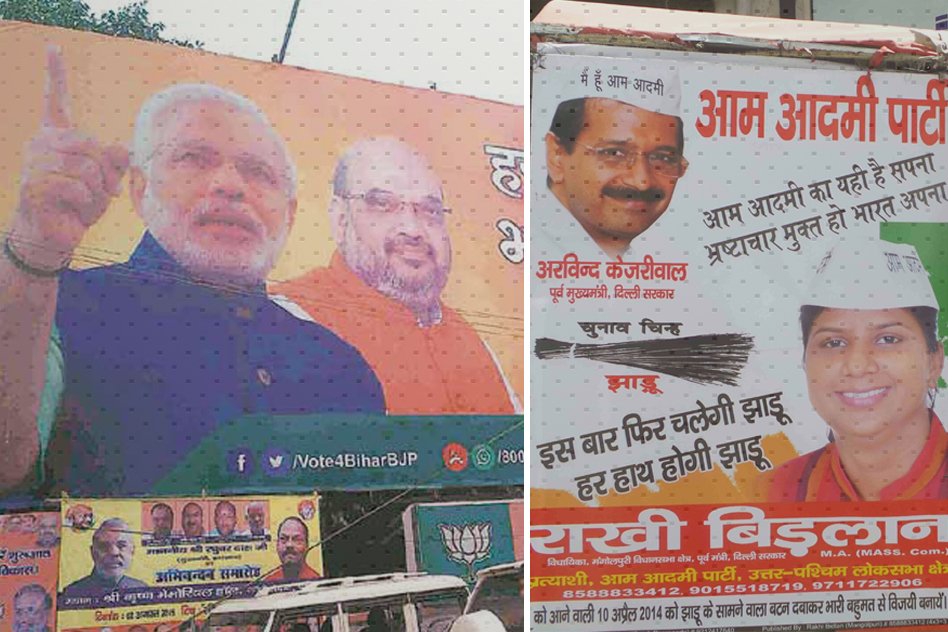Image Courtesy: elections indianexpress
It is generally believed that there is no dearth of money with the government. If the resources are not guzzled down in corruption and are instead spent efficiently on deserving sectors like education and health, the results can be spectacular. One hideous form of corruption which doesn’t often come into the limelight is the outrageous spending by governments on advertisements. Successive governments at state and national level have spent huge amounts of money on policy publicity and showcasing their own achievements. Let us take a look at some numbers and think where the line should be drawn for such expenditure.
■ All Political Parties crave publicity
Recently data on advertisement spending have emerged from the states of Maharashtra and Delhi. The BJP-Shiv Sena led Maharashtra government spent Rs 6.61 crore on advertisement in the period between April and December of 2015. This was almost 50% more than what the previous Maharashtra government led by Congress-NCP had spent in three full years. The previous government had spent Rs 4.25 crore between 2011 and 2014.
The Finance Minister of the state, Mr. Sudhir Mungantiwar, has defended the expenditure and said that it should not be seen as advertising and should instead be looked at as the cost incurred on establishing a dialogue with the public. “Keeping the information within the four walls of Mantralaya (Secretariat) is of no use. We need to disseminate this information to people and create awareness about the various government schemes.”
While publicizing a policy or a govt scheme among people is desirable, the advertisements generally tend to glorify the government or an individual. This is evident from the fact that out of Rs. 6.61 crore spent, Rs. 3.28 crore were used to celebrate the first anniversary of the Devendra Fadnavis government. It would have been much more prudent to instead spend that money in instalments throughout the year as and when new schemes were launched.
The Aam Aadmi Party-led government in Delhi has been even more generous in its advertisement spending. In the 11 months from February 2014 to January 2015, it has spent Rs. 60 crore in various forms of advertisements. In its budget last year, the government had put aside a whopping Rs. 526 crore for advertisements. Although this is only 1.3% of the Rs. 40,000 crore budget of Delhi, the amount still looks way too much for a small state.
AAP leader Ashutosh defends this expenditure and says that the government needs to inform people about its policies and that is why there is a publicity budget for communicating with people. He also tells that for the first time a separate department for publicity and advertisement has been created in the Delhi govt, and that the expenditure may be less than what the individual departments used to spend earlier.
While the success of the anti-corruption helpline in the early months of the govt or the recent odd-even scheme of pollution control can be attributed to the massive advertisement blitzkrieg, other ads targeted at the Prime Minister or the Delhi Police are definitely not called for. Advertisement done from the taxpayers’ money should only be used to make them aware of the government’s schemes, not its achievements or propaganda.
The Central governments have also been extravagant when it comes to publicity and promotion. According to the response to RTI application filed by Factly, the UPA-I govt spent an average of Rs 312 crore per year during its five-year tenure. The amount more than doubled to Rs. 696 crore during UPA-II rule. The present NDA govt at Centre has spent Rs. 993 crore during its first year.
■ The Way Forward
Clearly there is a need for regulating such disproportionate spending on advertisements. There should be an upper cap on the amount a government can spend on publicity. Every year a small percentage of the annual budget of the state/Centre can be earmarked for promotional activities which should cover every form of advertisement a government can give: print, television, radio and outdoor.
The Judiciary can keep a watch on the expenditure and issue guidelines from time-to-time, like it did few months back when it restrained ruling parties from publishing photographs of political leaders or prominent persons in government-funded advertisements. Further, governments must explore other means of publicity like social media, which is cheaper than conventional platforms and has an ever-growing outreach.
The Logical Indian community encourages the governments to exercise self-scrutiny in their advertisement spending and look for smarter ways to reach out to people, to ensure that every penny of the taxpayer’s money is spent on things that really matter to him.
– Abhishek Mittal











